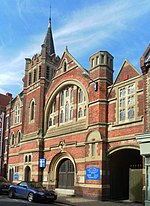Grove Road Strict Baptist Church
1881 establishments in England19th-century Baptist churches19th-century churches in the United KingdomBaptist churches in East SussexChurches completed in 1881 ... and 3 more
Churches in EastbourneEnglish church stubsStrict Baptist chapels

The Grove Road Strict Baptist Church, is a Strict Baptist place of worship in the town of Eastbourne in the English county of East Sussex. The chapel was built in 1881. J.J. Skinner's 1881 red brick and stone chapel replaced an earlier Strict Baptist place of worship, Marsh Chapel, which was founded in the first few years of the 19th century. Reordering was carried out inside in 2002. The church is aligned with the Gospel Standard movement.The church was licensed for worship in accordance with the Places of Worship Registration Act 1855 and was given the registration number 25941.
Excerpt from the Wikipedia article Grove Road Strict Baptist Church (License: CC BY-SA 3.0, Authors, Images).Grove Road Strict Baptist Church
Grove Road,
Geographical coordinates (GPS) Address External links Nearby Places Show on map
Geographical coordinates (GPS)
| Latitude | Longitude |
|---|---|
| N 50.768 ° | E 0.2796 ° |
Address
Grove Road Baptist Chapel
Grove Road
BN21 4TY , Meads
England, United Kingdom
Open on Google Maps






